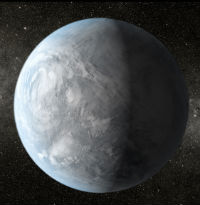
Kepler-62e
I have always thought that our planet was misnamed. Earth is a synonym for dirt, even though 72% is covered by water. Now, it appears that scientists may have discovered two distant water worlds even wetter than our own misnamed watery planet.
Astronomers have discovered a solar system of five planets orbiting Kepler-62, a red dwarf star about 1,200 light-years from Earth in the constellation Lyra. Two of the five planets are in what is considered the “habitable zone”— the area at which the planets receive enough light and warmth that liquid water could theoretically exist on their surfaces. Now, researchers at the Harvard-Smithsonian Center for Astrophysics have concluded that both planets may be water worlds, their surfaces completely covered by a global ocean with no dry land to speak of.
“These planets are unlike anything in our solar system. They have endless oceans,” said lead author Lisa Kaltenegger of the Max Planck Institute for Astronomy and the CfA. “There may be life there, but could it be technology-based like ours? Life on these worlds would be under water with no easy access to metals, to electricity, or fire for metallurgy. Nonetheless, these worlds will still be beautiful, blue planets circling an orange star — and maybe life’s inventiveness to get to a technology stage will surprise us.”
The two planets, designated as Kepler-62e and Kepler-62f, were discovered by the Kepler space telescope, two of thousands of exoplanet candidates discovered by the spacecraft. Kepler-62e is about 1.6 times the radius of Earth and orbits its parent red dwarf star about once every 122 days whereas Kepler-62f is 1.4 the radius of Earth and rotates about the star every 267 days.
From the Daily Galaxy blog: Kepler-62e is 60 percent larger than Earth, while Kepler-62f is about 40 percent larger, making both of them “super-Earths.” They are too small for their masses to be measured, but astronomers expect them to be composed of rock and water, without a significant gaseous envelope.
As the warmer of the two worlds, Kepler-62e would have a bit more clouds than Earth, according to computer models. More distant Kepler-62f would need the greenhouse effect from plenty of carbon dioxide to warm it enough to host an ocean. Otherwise, it might become an ice-covered snowball.
“Kepler-62e probably has a very cloudy sky and is warm and humid all the way to the polar regions. Kepler-62f would be cooler, but still potentially life-friendly,” said Harvard astronomer and co-author Dimitar Sasselov.
